HUGHES-STANTON, Blair Rowlands
Blair Rowlands Hughes-Stanton was born at Kensington, London on 22 February 1902, second child and only son of the four children of Royal Academician, Sir Herbert Edwin Pelham Hughes-Stanton (21 November 1870-2 August 1937), who had added Stanton into his surname, and his wife Elizabeth (Bessie) Cobden née Rowlands (4 January 1870-15 March 1940), who married at Marylebone, London in 1898. Blair was educated at Colet Court School in London and at the age of 13, joined the Royal Navy training ship H.M.S. Conway but six years later, on the advice of his father, he studied at the Byam Shaw School of Art 1919-1922 and the Royal Academy Schools 1922-1923. He attended evening classes at Leon Underwood's (1890-1975) newly established Brook Green School of Art at Hammersmith. Underwood’s remained the dominant influence on him and in 1923 the American wood engraver Marion Mitchell (1903-1996), introduced him to wood engraving, which set the direction of his life. Other Mitchell pupils included sculptor Henry Moore (1898-1986) and Gertrude Anna Bertha Hermes (18 August 1901-9 May 1983) who Hughes-Stanton married in 1926, and they had two children, Judith (born 1927) and Simon (born 1928). In 1928, afte his 10 Hammersmith Terrace flat became flooded, he rented a cottage at Hacheston, Suffolk where Henry Moore spent part of his honeymoon with Irena Anatolia Radetsky (1907-1989) in a tent in the garden. In 1930 Hughes-Stanton and Hermes, along with William McCance (1894-1970) and Agnes Miller Parker (1895-1980), were appointed in various capacities to the artistic and business management of the Gregynog Press. In 1930 he began an affair with Ida Graves which he celebrated with his work 'Rebirth' and relations were strained with some of the board at Gregynog who felt that Hughes-Stanton's wood engravings were too erotic, and his personal conduct was upsetting both Margaret (1884-1963) and Gwendoline Davies (1882-1951), who owned the press. About this time Hughes-Stanton produced his best works, wood engravings for ‘Comus’ by John Milton in 1931, ‘Erewhon’ by Samuel Butler in 1932 and ‘The Revelation of Saint John the Divine, Four Poems’ by Milton and ‘The Lamentations of Jeremiah’, all of which appeared in 1933. In March 1932, Hermes left Hughes-Stanton and moved back to London, where she stayed with Leon George Claude Underwood (1890-1975) and later divorced Blair. Hughes-Stanton left the Gregynog Press in September 1933 when Blair and Ida moved to Higham on the Essex/Suffolk borders from where Blair founded the Gemini Press and in 1934 the press produced ‘Epithalamion’ by Ida Graves, with twenty-three full-page wood engravings by Hughes-Stanton; the book is a celebration of their physical and spiritual wedding, even though they were unable to marry. They later moved to a late medieval timber house in Stratford St Mary, Suffolk on which they spent many years restoring. By 1939, their relationship was at an end and in 1940 he joined the Royal Engineers, serving in the Middle East and then transferred to Greece, where he was captured and where a prison guard in the temporary P.O.W. camp at Corinth shot him in the throat and skull when he strayed too close to the wire. His injury incapacitated him as he moved to a series of camps in Germany, and he was finally repatriated in August 1943. Hughes-Stanton had already started teaching at the Winchester School of Art before the war, and now became increasingly reliant on teaching, at Colchester School of Art 1945-1947, St Martin's School of Art 1947-1948 and the Central School of Arts and Crafts and even in his seventies he was teaching at Winchester School of Art. He had very few commissions during this period, and the engravings for his best-known book from this period ‘The Confessions of an English Opium Eater’ by Thomas de Quincey (Folio Society, 1948 and 1963) had been engraved in the early 1930s for the Fanfrolico Press. Hughes-Stanton left Ida Graves in 1950, taking refuge with Gertrude Anna Bertha Hermes (1901-1983) and in 1952 he married Anne Penelope Ross (19 September 1919-4 March 1996), a former student, with whom he had two daughters, Penelope (born 1954) and Chloë (born 1955). Blair, of North House, Manningtree, Essex died at Kings Lynn, Norfolk on 6 June 1981, and his ashes were scattered on the River Stour, Suffolk by two friends from the local public house. Although he did some work in oils and spent a great deal of time experimenting with linocuts in his later years, Hughes-Stanton's artistic production consists mostly of wood engravings.
Royal Academy Exhibits
from North House, Manningtree, Essex
1957 1218 Birth of Aphrodite – pen
1966 1121 Rock Pool
1127 Eclipse
1967 813 The Wave
818 Moonshine
822 The Rock
1968 618 Thunderstorm
619 Summer Storm
633 The Cove
1969 933 The Beast in the Jungle – linocut
1971 182 Jacob and Laban – lithograph
185 The Fall – linocut
Works by This Artist
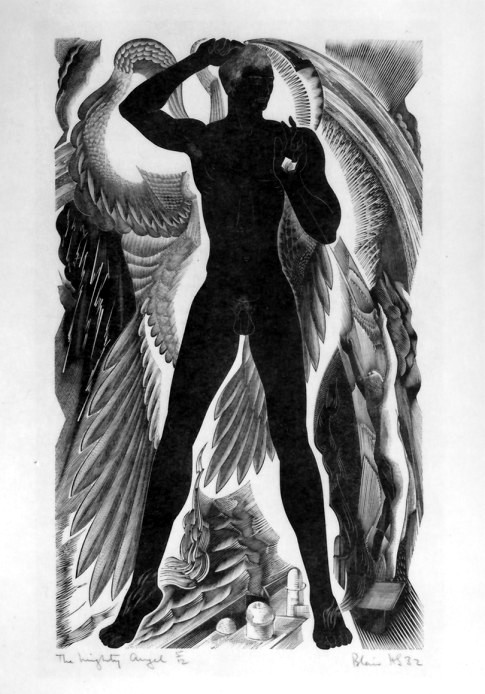
|
The Mighty AngelWood engraving
|
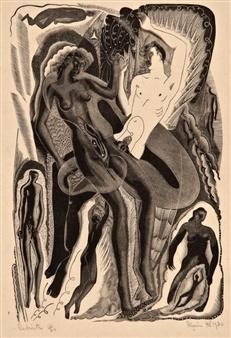
|
RebirthWood engraving on laid japan paper
|
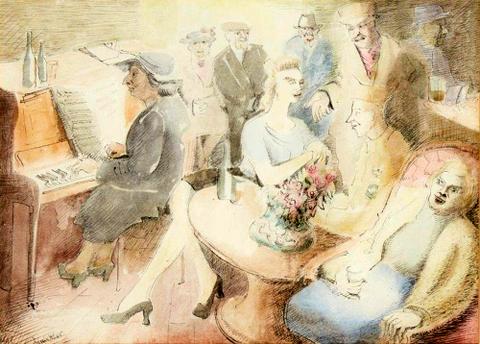
|
SongInk and watercolour
|
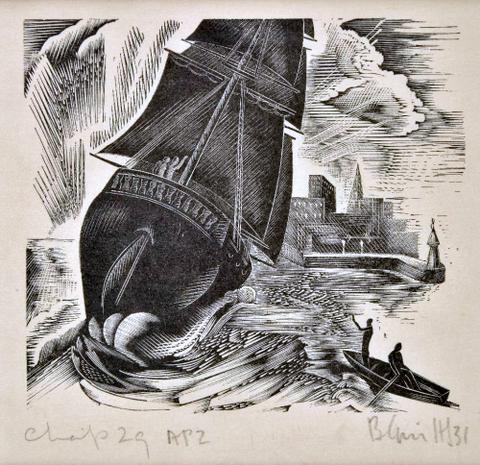
|
The ShipWood engraving on pale cream wove
|
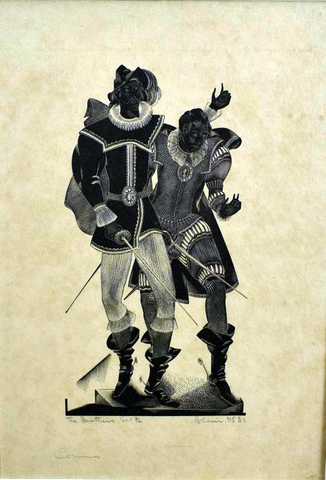
|
The Brothers from ComusWood engraving
|
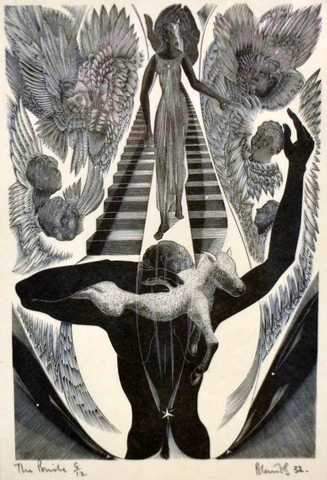
|
The BrideWoodcut
|